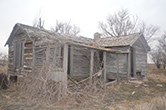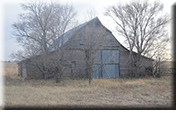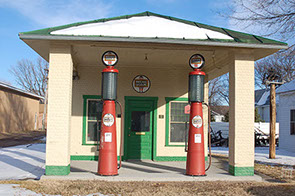

PHILLIPS COUNTY
Colorado

All materials contained on these pages are furnished for the free use of those engaged in researching their family origins. Any commercial use, without the consent of the host/author of these pages is prohibited. All images used on these pages were obtained from sources permitting free distribution, or generated by the author, and are subject to the same restrictions/permissions. All persons contributing material for posting on these pages does so in recognition of their free, non-commercial distribution, and further, is responsible to assure that no copyright is violated by their submission.
Last updated December 2018

To best understand the pride and progress of Holyoke, I think that it is best that we understand its true beginnings. In these early days there was plenty of unoccupied land beyond the Missouri. The land seemed to be pretty useless and there was no rush to settle here. After the treaty of 1861, cattle men began bringing their herds here, letting them roam upon the free range.
To induce the easterners to move West, Lincoln signed the Homestead Act of 1862, which opened the flood gate for settling the west. In 1884, homesteading began in earnest after glowing report of great land to the west reach the east coast papers.
Many times, settlers waited for days on the outskirts of towns, waiting for land to be opened for sale. Men like David Ritter, Louis Glynn and Mason Cavy settled on the prairie in sod houses and bravely faced the odds when they traveled to Julesburg, Sterling, Greeley and even Denver for business, supplies, mail and work. With the coming of the Burlington and Missouri Railroad (later known as the Colorado and Wyoming Rail Road) in 1887, the Lincoln Land Company began laying out the towns along its route.
After a bitter cold winter, Holyoke, which was named after Holyoke, Massachusetts, became one of the first towns to incorporate on April 24, 1888. With a population of 800, it became the railroad division point. It boasted a roundhouse, turntable, coal house, ice house, and a depot with an eating house which stood 2 stories tall and measured 36 x 110 feet. By the end of the year Holyoke had 75 building and by the incorporation of the county there were 123 business and residences and 50 miscellaneous building.
Since Phillips County was not yet a county in 1887, Holyoke and its citizens were anxious to acquire the distinction of being the county seat of Logan County, as was Sterling and Atwood. But after a vote of the counties citizenry, Sterling was designated the county seat of Logan county. Holyoke would have to wait 2 more years before in gained the title for Phillips County.
Most of its streets were named for important people in the community, but there is some question as to the naming of the street named “Interocean”. Some believe it was named because the Pacific Ocean is on one side and the Atlantic is on the other, others say that it was a slam against the Union Pacific, but I would like to offer this suggestion…? Might it come from the fact that the area was once covered by a inland sea…Hence the name Interocean?
The Burlington eating house, one of Holyoke’s fine eating establishments, with its large fireplace and polished ballroom floor, shared the distinction of “elegance” only with the Gordon House which also held frequent balls and lavish dinners. The Adland Mozart Store which was 5 miles west and 3 miles south of Holyoke was operating as early as 1885. The Logan County News ran an advertisement once stating that it was “As cheap as the Cheapest.” Adland moved the store to Holyoke in 1887.
1887 was the year of firsts for Holyoke. In September a post office was established, the first newspaper in the county, The Logan County News was started and a daily stage ran between Holyoke and Julesburg.
In the 1890’s, 1500 shade trees were planted by the city marshal, and ordinance requiring delivery and express wagon to be licensed and another one permitting druggists to sell liquor for medical purpose were all enacted. During the hard years of 1894 and 95, Slater and Arnold placed the following ad “ We fully realize times are hard and money scarce and farm products too cheap, and in order to help you as well as ourselves we will take wheat, corn, hogs ,butter, eggs and chickens in exchange for any goods we handle”.
In 1898 the Beatrice Company opened a creamery in town, milk came to the creamery in big cans hauled in on wagons, the cream was then separated from the milk and the skimmed milk was then returned to the farm to be fed to the stock. The B and M installed scales for the benefit of the ranchers an F H Whitham put a wagon scale in from of his store. For entertainment, moving pictures were shown at the G.A.R hall, the cost....35 cents for a reserved seat.
1900 saw the population grow to 1,583. The new Sears Hotel offered a square meal for 25 cents, the high school proposition passed. H L Chase opened a photo gallery and Dr F M Mears took over Dr. Nobie's office. In 1903 a telephone line from Haxtun to Holyoke was completed and plans were then made to run a line to Sterling and one from Wray to Brush.
Barbed wire lines ran in every direction from Holyoke. Automobiles started to appear in 1904; Omat Flora used his horseless carriage to carry the mail from Holyoke to Julesburg. Will White started threshing with a steam thresher and H B Peterson started his gas engine and his 6, 14” plows to work his farm southeast of Holyoke, the first of its kind in Colorado.
The first National Bank of Holyoke open in 1908, and the town was lit with electric lights in 1909. By 1913 a coast to coast highway ran through Holyoke, there was a road to Wray and the Holyoke Auto company had a gasoline tank out front.
Business Listing 1911 Business listing 1889
THE TOWN OF HOLYOKE



.jpg?crc=405273837)

OLD HOLYOKE SQUARE
WHITE ROSE GAS STATION
BURGE HOTEL
PLEASANT PRAIRIE SCHOOL

DOWNTOWN 1920'S COURTESY OF BETTY
DOWNTOWN